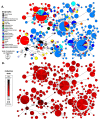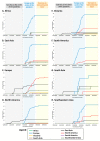Phylogeography of 27,000 SARS-CoV-2 Genomes: Europe as the Major Source of the COVID-19 Pandemic
- PMID: 33137892
- PMCID: PMC7693378
- DOI: 10.3390/microorganisms8111678
Phylogeography of 27,000 SARS-CoV-2 Genomes: Europe as the Major Source of the COVID-19 Pandemic
Abstract
The novel coronavirus SARS-CoV-2 emerged from a zoonotic transmission in China towards the end of 2019, rapidly leading to a global pandemic on a scale not seen for a century. In order to cast fresh light on the spread of the virus and on the effectiveness of the containment measures adopted globally, we used 26,869 SARS-CoV-2 genomes to build a phylogeny with 20,247 mutation events and adopted a phylogeographic approach. We confirmed that the phylogeny pinpoints China as the origin of the pandemic with major founders worldwide, mainly during January 2020. However, a single specific East Asian founder underwent massive radiation in Europe and became the main actor of the subsequent spread worldwide during March 2020. This lineage accounts for the great majority of cases detected globally and even spread back to the source in East Asia. Despite an East Asian source, therefore, the global pandemic was mainly fueled by its expansion across and out of Europe. It seems likely that travel bans established throughout the world in the second half of March helped to decrease the number of intercontinental exchanges, particularly from mainland China, but were less effective between Europe and North America where exchanges in both directions are visible up to April, long after bans were imposed.
Keywords: SARS-COV-2 lineages; intercontinental founders; molecular epidemiology; phylogenomics; phylogeography; travel bans.
Conflict of interest statement
The authors declare no conflict of interest. The funders had no role in the design of the study; in the collection, analyses, or interpretation of data; in the writing of the manuscript, or in the decision to publish the results.
Figures


References
-
- Latham J., Wilson A. A Proposed Origin for SARS-CoV-2 and the COVID-19 Pandemic. [(accessed on 23 October 2020)];Independent Science News. Available online: https://www.independentsciencenews.org/commentaries/a-proposed-origin-fo...
Grants and funding
LinkOut - more resources
Full Text Sources
Miscellaneous

